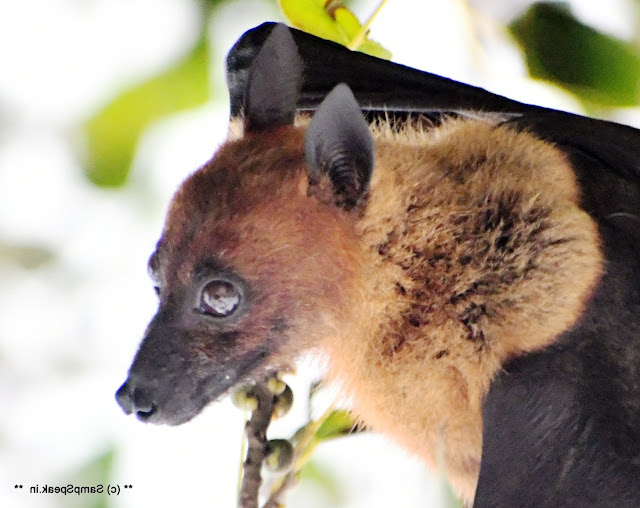Imp Pre-script : Read / see the photos at your own risk .. don’t blame me ! –they are hideous and scary too !! – and much much bigger than what I had seen earlier – somewhat resembling monkeys, face looking like a dog or a fox even !!
At Multan today, England’s weaponry against Paki bat was raw pace in a raw match situation. A weapon that had failed most tourists on unforgiving subcontinent wickets - that point of difference to unlock well-set batters and deliver the moments that make victory possible. On a nerve-shredding fourth and final day in Multan, Mark Wood was that man, as Pakistan's gutsy pursuit of 355 was thwarted with just 26 runs left to defend. Today it clearly was the ball over the bat !!
For more than 120 years of existence in International cricket, the bat has undergone lots of changes – perhaps there has not been significant change in the grip, the quality of willow but the weight, perceived quality and weight have. Present day bats held by star batsmen display not manufacturers’ names but mostly the sponsors. There are many and varied manufacturers such as : Symonds, Slazenger, Gunn & Moore, Gray Nichols, Puma, BDM, MRF and more….. those days – there were oil and non-oil bats -there were stories of seasoning and oiling the oil bats. At one point time, there were reports that Sunil Gavaskar’s bat had some small pint holes on the back side of the bat which aided him when he drove the ball. The bats of English willow were expertly pressed and there would be procedures of oiling with linseed oil and knocking them over. Those days Clive Lloyd, Viv Richards and Sandip Patil used heavier bats – now there are many who wield the willow like a bludgeon – resultantly, even a shot not hit in the sweet spot disappears into the crowd, making the life of spinners miserable. This is not about Cricket but about bats !!
We have seen them on some old temples, I have seen them at Thavana uthsava bungalow gori !! - the Egmore Museum houses priceless artifacts; also houses colonies of fruit bats in the trees outside. Last year, I saw them arrive with a buzz around 615 – 630 pm – close to hundred – flying with unerring precision from nowhere and hanging on the Arasa maram [peepal tree] at Vasavi Parthas, Venkatrangam Street, Triplicane, Chennai 600005. Though have been seeing them encircling in recent times, today was different – as I saw them close, with some fear and photographed them.
When we think of bats, an unfavorable image often comes to mind. Whether it's the scary portrayal of them in vampire films and literature or a general fear of how their real-life counterparts might transmit viruses, bats have gotten a bad rap that's actually more fiction than fact. Understand that there are more than 1,400 bat species in the world ! Bats can be as large as a small dog or as small as a bee. The ones that come nearer home resemble crows !! The largest bats are the flying foxes with wingspans of up to 2 metres and a body weights of up to 1.5 kilograms.
Bats are mammals of the order Chiroptera. With their forelimbs adapted as wings, they are the only mammals capable of true and sustained flight. Bats are more manoeuvrable than birds, flying with their very long spread-out digits covered with a thin membrane or patagium. The second largest order of mammals after rodents, bats comprise about 20% of all classified mammal species worldwide. For centuries, bats have been called sinister and spooky, likely because of their beady eyes and razor-sharp fangs. But there’s more to these nocturnal creatures than meets the eyes. The scientific name for bats Chiroptera, is Greek for “hand wing.” That’s because bats have four long fingers and a thumb, each connected to the next by a thin layer of skin. To navigate dark caves and hunt after dark, microbats rely on echolocation, a system that allows them to locate objects using sound waves. They echolocate by making a high-pitched sound that travels until it hits an object and bounces back to them. This echo tells them an object’s size and how far away it is.
The age-old question of upside down bats. Yes, it is awfully weird that there is an animal—a mammal even—that hangs upside down. Sure, some monkeys do it when they're just monkeying around. Bats are the only animals that actually spend most of their time hanging upside down: feeding this way, raising their young this way, and, yes, sleeping or roosting this way. Bats are not birds, nor are they insects. The difference between bat flight and bird or insect flight is weight—specifically, the ratio of weight to lift-capacity of the wings. Birds have hollow bones; bats don’t. To compensate for the extra weight that mammals must have, to compensate for the problem of getting off the ground, evolution found another way for bats to transition from being motionless to immediately being able to fly when necessary.
Though they reportedly are harmless, they scare us and in the twilight – crows do appear agitated, when these bats start homing in to the peepal tree.
Any comments !!!
12.12.2022

.jpg)
.jpg)
.jpg)
.jpg)
.jpg)
.jpg)
.jpg)
.jpg)
.jpg)
.jpg)
Anna, such detailed description of bats...echolocation, like sonar under water....such adaptation, not hollow but dense bones .....Thank you for this...such an enjoyable read
ReplyDeleteYes. Very fearful. I had never seen bats like this....!!!resembling monkeys, face looking like a dog or a fox even !! Very nice photos....
ReplyDelete